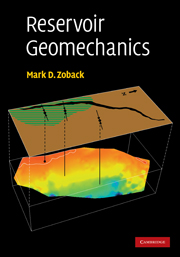Book contents
- Frontmatter
- Contents
- Preface
- PART I BASIC PRINCIPLES
- PART II MEASURING STRESS ORIENTATION AND MAGNITUDE
- 6 Compressive and tensile failures in vertical wells
- 7 Determination of S3 from mini-fracs and extended leak-off tests and constraining the magnitude of SHmax from wellbore failures in vertical wells
- 8 Wellbore failure and stress determination in deviated wells
- 9 Stress fields – from tectonic plates to reservoirs around the world
- PART III APPLICATIONS
- References
- Index
- Plate section
7 - Determination of S3 from mini-fracs and extended leak-off tests and constraining the magnitude of SHmax from wellbore failures in vertical wells
Published online by Cambridge University Press: 10 December 2009
- Frontmatter
- Contents
- Preface
- PART I BASIC PRINCIPLES
- PART II MEASURING STRESS ORIENTATION AND MAGNITUDE
- 6 Compressive and tensile failures in vertical wells
- 7 Determination of S3 from mini-fracs and extended leak-off tests and constraining the magnitude of SHmax from wellbore failures in vertical wells
- 8 Wellbore failure and stress determination in deviated wells
- 9 Stress fields – from tectonic plates to reservoirs around the world
- PART III APPLICATIONS
- References
- Index
- Plate section
Summary
As mentioned at the outset of this book, arriving at practical solutions to many problems in geomechanics requires knowledge of the magnitude and orientation of all three principal stresses. This is well illustrated by the range of geomechanical topics and case studies presented in Chapters 10–12. The first subject discussed in this chapter is the magnitude of the least principal stress, S3, as obtained by hydraulic fracturing, specifically mini-frac (or micro-frac) tests done specifically for the purpose of measuring stress. As discussed at length below, because hydraulic fracturing frequently occurs during leak-off tests (LOT's) and especially extended leak-off tests (XLOT's), these tests also can be used to determine S3. In normal and strike-slip faulting environments,S3 is equivalent to Shmin. In reverse faulting environments, S3 is equivalent to Sv. Methods for determination of Shmin from Poisson's ratio (obtained from P- and S-wave sonic logs) are based on questionable physical and geologic assumptions. These methods will be discussed briefly in Chapter 9. Suffice it to say at this point that direct measurement of the least principal stress through some form of hydraulic fracturing is the only reliable method known that is practical to use in wells and boreholes at any appreciable depth.
One can determine the magnitude of the least principal stress from a micro-frac, a very small-scale hydraulic fracture induced only to measure stress at a particular depth, usually at a specific depth through perforations in cemented casing.
Information
- Type
- Chapter
- Information
- Reservoir Geomechanics , pp. 206 - 234Publisher: Cambridge University PressPrint publication year: 2007
Accessibility standard: Unknown
Why this information is here
This section outlines the accessibility features of this content - including support for screen readers, full keyboard navigation and high-contrast display options. This may not be relevant for you.Accessibility Information
- 2
- Cited by
